BUICK CENTURY 1997 User Guide
Manufacturer: BUICK, Model Year: 1997, Model line: CENTURY, Model: BUICK CENTURY 1997Pages: 406, PDF Size: 20.64 MB
Page 11 of 406
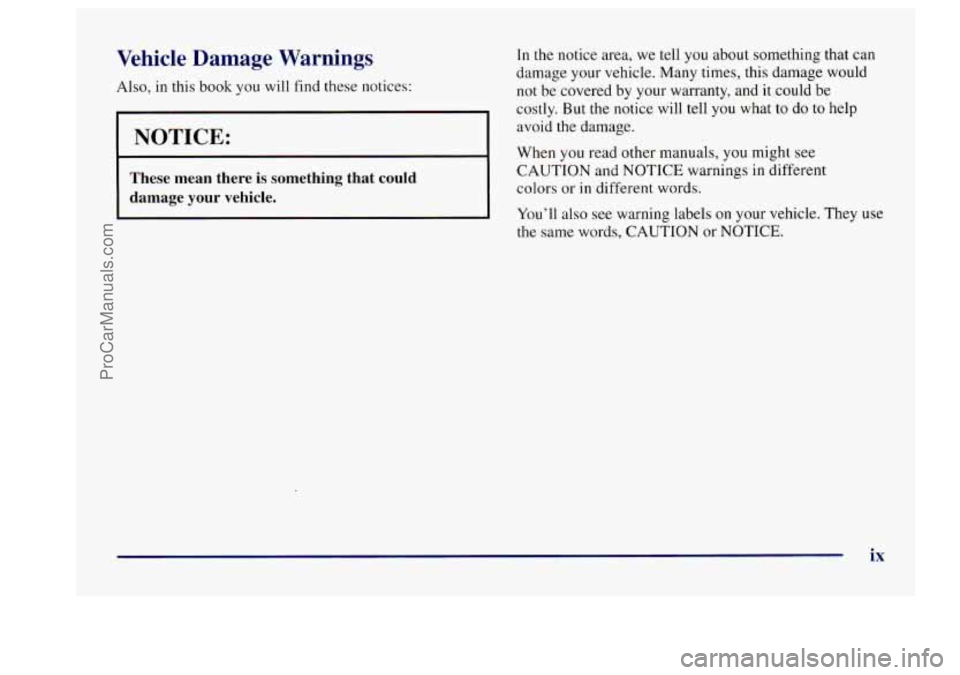
Vehicle Damage Warnings
Also, in this book you will find these notices:
I NOTICE:
These mean there is something that could
damage your vehicle.
In the notice area, we tell you about something that can
damage your vehicle. Many times, this damage would
not be covered by your warranty, and
it could be
costly.
But the notice will tell you what to do to help
avoid the damage.
When
you read other manuals, you might see
CAUTION and NOTICE warnings in different
colors or
in different words.
You’ll also
see warning labels on your vehicle. They use
the same words, CAUTION or NOTICE.
ix
ProCarManuals.com
Page 12 of 406
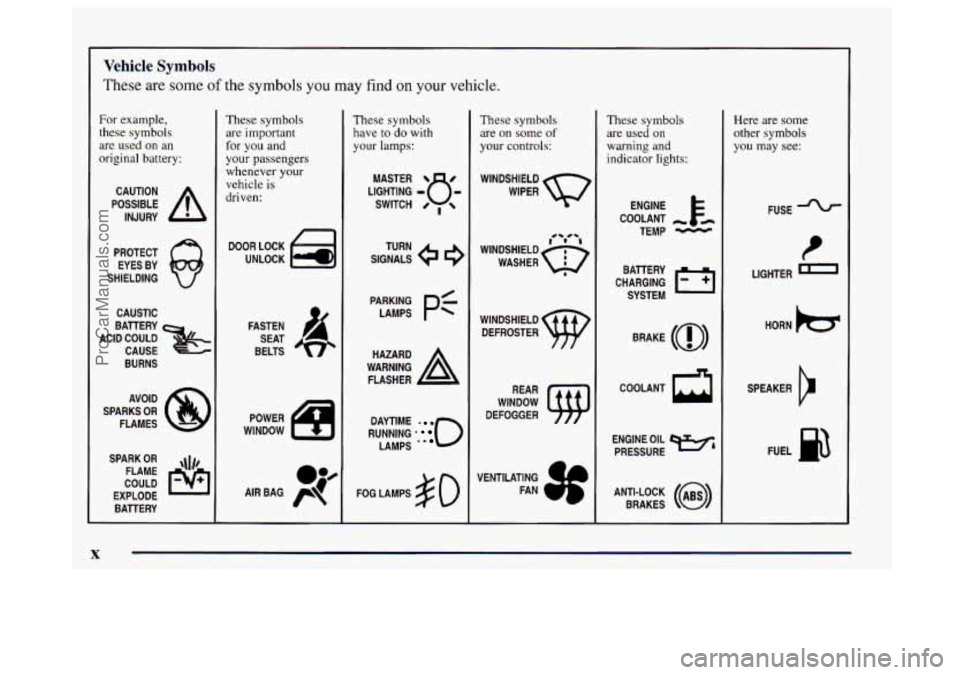
Vehicle Symbols
These are some of the symbols you may find on your vehicle.
For example,
these symbols
are used on an
original battery:
POSSIBLE A
CAUTION
INJURY
PROTECT EYES
BY
SHIELDING
CAUSTIC
BATTERY
CAUSE
BURNS
ACID COULD
&
AVOID
SPARKS
OR
FLAMES
SPARK
OR ,\I/,
COULD FLAME
EXPLODE BATTERY
. K
These symbols
are important
for you and
your passengers
whenever your
vehicle is
driven:
DOOR LOCK
UNLOCK
FASTEN SEAT
BELTS
These symbols have to do with
your lamps:
SIGNALS e
TURN
WARNING
A
HAZARD
FLASHER
RUNNING
' 0
DAYTIME rn
LAMPS .*
FOG LAMPS $0
These symbols
are on some
of
your controls:
WINDSHIELD
WIPER
WINDSHIELD DEFROSTER
WINDOW
DEFOGGER
These symbols are used
on
warning and
indicator lights:
ENGINE t
COOLANT - tm
TEMP -
CHARGING I-1
BATTERY
SYSTEM
BRAKE
(0)
COOLANT a
ENGINE OIL e,
PRESSURE
ANTI-LOCK
(@)
BRAKES
1
Here are some
other symbols
you may see:
FUSE
t
LIGHTER
HORN
)cr
SPEAKER
b
FUEL p3
ProCarManuals.com
Page 13 of 406
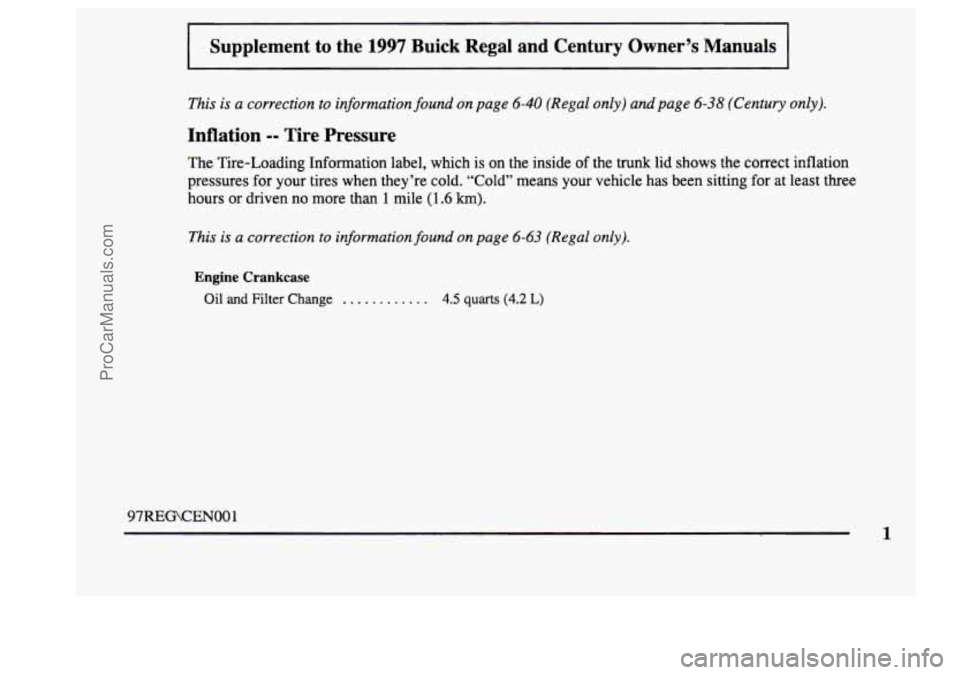
I Supplement to the 1997 Buick Regal and Century Owner’s Manuals
This is a correction to information found on page 6-40 (Regal only) and page 6-38 (Century only).
Inflation -- Tire Pressure
The Tire-Loading Information label, which is on the inside of \
the trunk lid shows the correct inflation
pressures for your tires when they’re cold.
“Cold” means your vehicle has been sitting for at least three
hours or driven no more than
1 mile (1.6 km).
This is a correction to information found on page 6-63 (Regal only).
Engine Crankcase
Oil and Filter Change . . . . . . . . . . . . 4.5 quarts (4.2 L)
97RECKEN001
1
ProCarManuals.com
Page 14 of 406
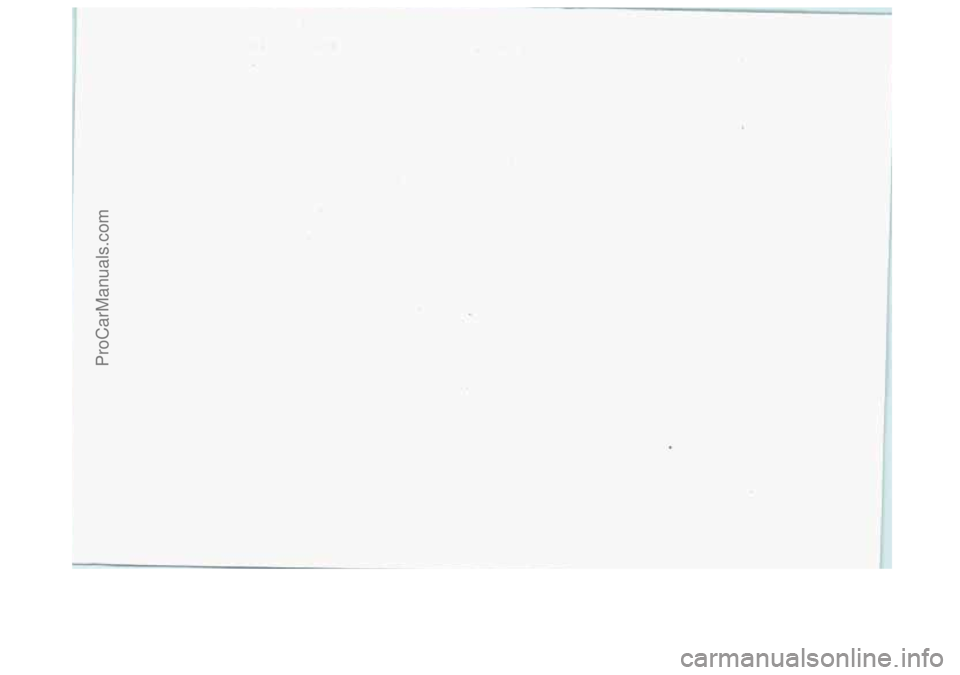
- ',. j
ProCarManuals.com
Page 15 of 406
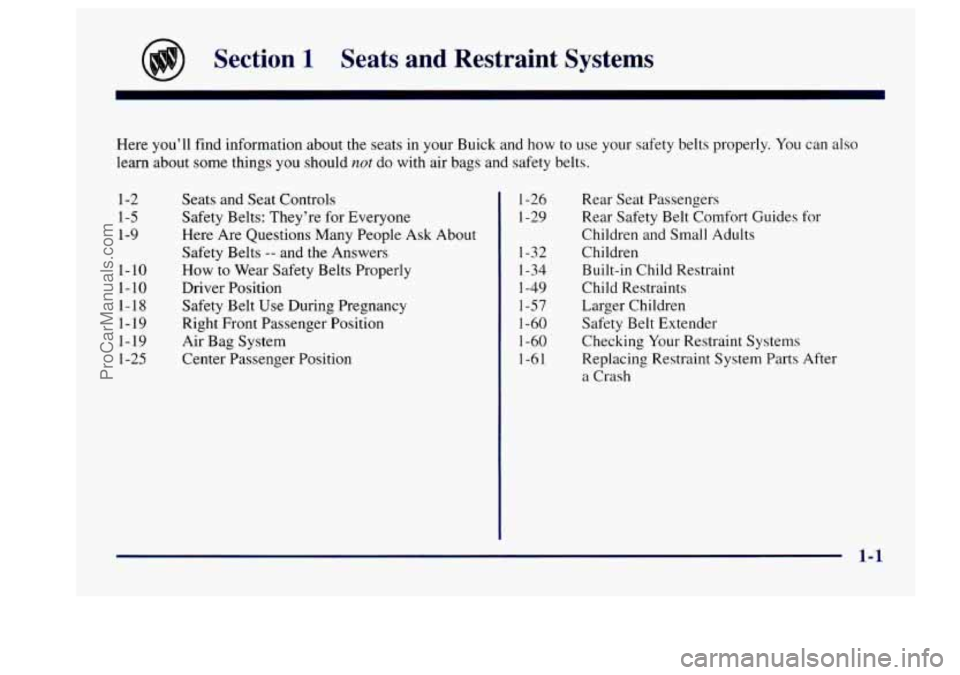
Section 1 Seats and Restraint Systems
Here you’ll find information about the seats in your Buick and how to use your safety belts properly. You can also
learn about some things
you should not do with air bags and safety belts.
1-2
1-5
1-9
1-10
1- 10
1-18
1-19
1-19
1-25 Seats
and Seat Controls
Safety Belts: They’re for Everyone
Here Are Questions Many People Ask About
Safety Belts
-- and the Answers
How to Wear Safety Belts Properly
Driver Position Safety Belt Use During Pregnancy
Right Front Passenger Position
Air Bag System
Center Passenger Position 1-26
1-29 1-32
1-34
1-49
1-57
1-60
1-60
1-61 Rear
Seat Passengers
Rear Safety Belt Comfort Guides for
Children and Small Adults
Children Built-in Child Restramt
Child Restraints
Larger Children
Safety Belt Extender
Checking Your Restraint Systems
Replacing Restraint System Parts After
a Crash
1-1
ProCarManuals.com
Page 16 of 406
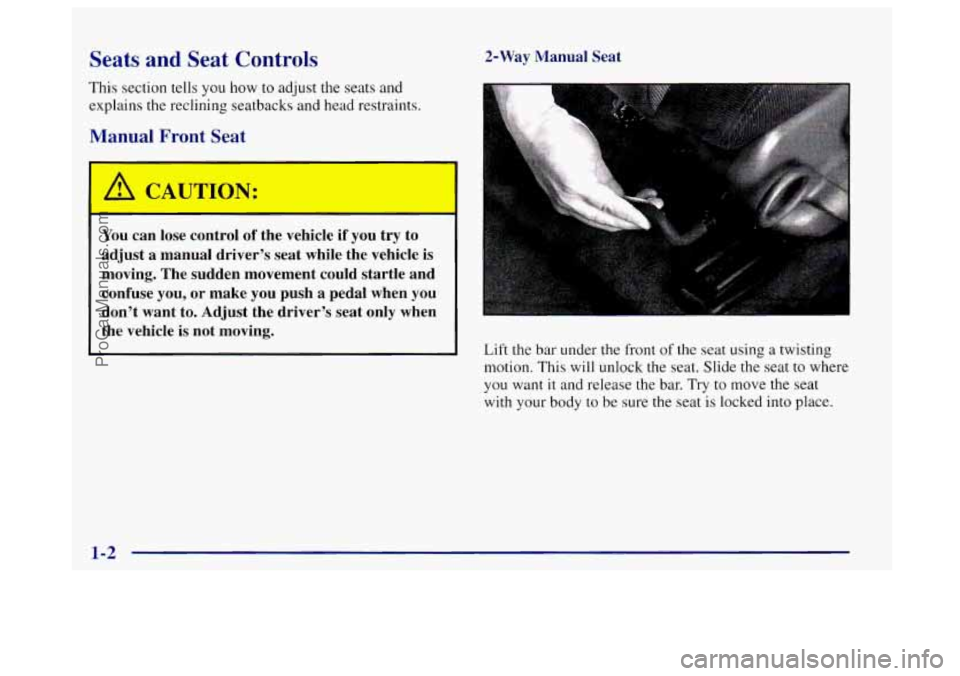
Seats and Seat Controls
This section tells you how to adjust the seats and
explains
the reclining seatbacks and head restraints.
Manual Front Seat
CAUTION:
You can lose control of the vehicle if you try to
adjust
a manual driver’s seat while the vehicle is
moving. The sudden movement could startle and
confuse you, or make you push
a pedal when you
don’t want to. Adjust the driver’s seat only when
the vehicle
is not moving.
I
2-Way Manual Seat
Lift the bar under the front
of the seat using a twisting
motion. This will unlock the seat. Slide
the seat to where
you want
it and release the bar. Try to move the seat
with your body
to be sure the seat is locked into place.
1-2
ProCarManuals.com
Page 17 of 406
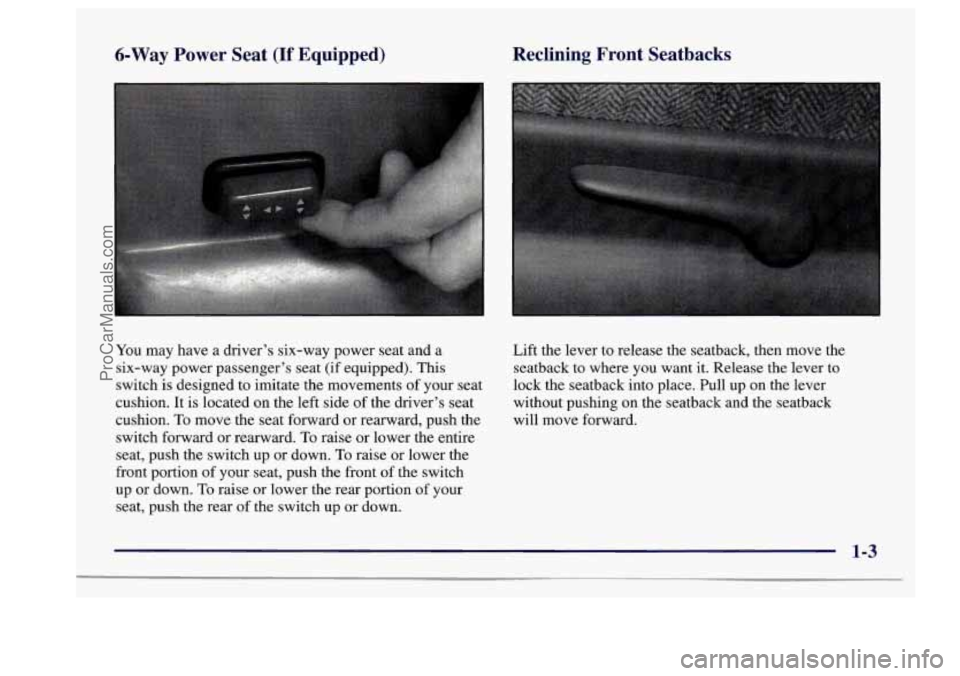
6-Way Power Seat (If Equipped) Reclining Front Seatbacks
You
may have a driver’s six-way power seat and a
six-way power passenger’s seat (if equipped). This
switch is designed to imitate the movements of your seat
cushion. It is located on the left side of the driver’s seat
cushion.
To move the seat forward or rearward, push the
switch forward or rearward.
To raise or lower the entire
seat, push the switch up or down.
To raise or lower the
front portion of your seat, push the front of the switch
up or down.
To raise or lower the rear portion of your
seat, push
the rear of the switch up or down. Lift the lever
to release the seatback, then move the
seatback to where you want it. Release the lever to
lock the seatback into place. Pull up on the lever
without pushing on the seatback and the seatback
will move forward.
1-3
ProCarManuals.com
Page 18 of 406
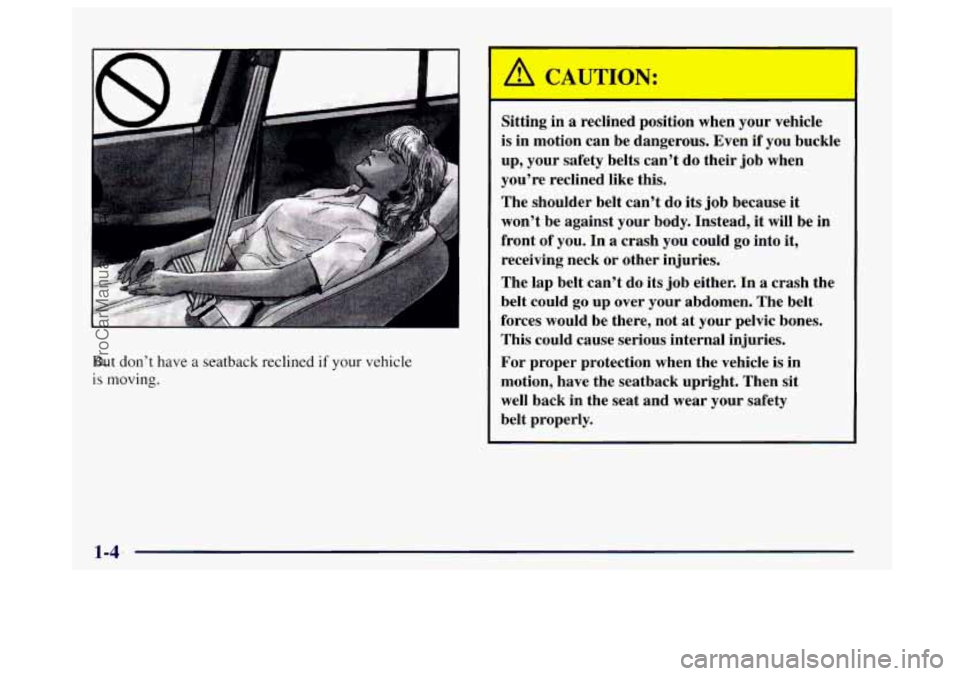
But don’t have a seatback reclined if your vehicle
is moving. Sitting in
a reclined position when your vehicle
is in motion can be dangerous. Even if you buckle
up, your safety belts can’t do their job when
you’re reclined like this.
The shoulder belt can’t do its job because it
won’t be against your body. Instead, it will be in
front of you. In
a crash you could go into it,
receiving neck or other injuries.
The lap belt can’t do its job either. In a crash the
belt could
go up over your abdomen. The belt
forces would be there, not at your pelvic bones.
This could cause serious internal injuries.
For proper protection when the vehicle is in
motion, have the seatback upright. Then sit
well back in the seat and wear your safety
belt properly.
1-4
ProCarManuals.com
Page 19 of 406
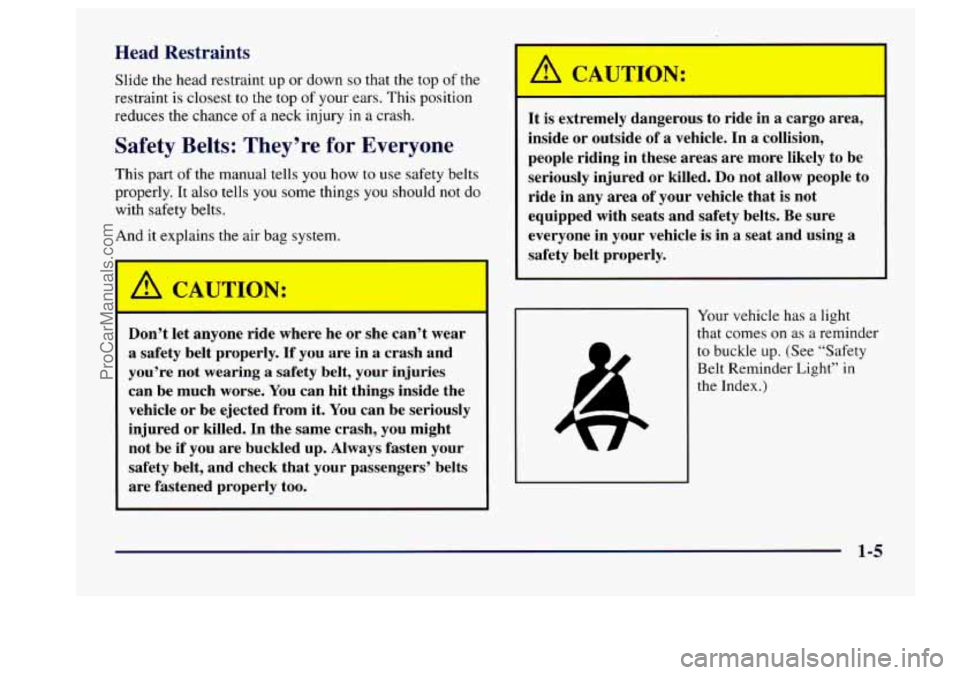
Head Restraints
Slide the head restraint up or down so that the top of the
restraint is closest to
the top of your ears. This position
reduces the chance
of a neck injury in a crash.
Safety Belts: They’re for Everyone
This part of the manual tells you how to use safety belts
properly. It also tells
you some things you should not do
with safety belts.
And
it explains the air bag system.
U I
Don’t let anyone ride where he or she can’t wear
a safety belt properly.
If you are in a crash and
you’re not wearing
a safety belt, your injuries
can be much worse. You can hit things inside the
vehicle or be ejected from it. You can be seriously
injured or killed. In the same crash, you might
not be
if you are buckled up. Always fasten your
safety belt, and check that your passengers’ belts
are fastened properly too.
‘
/d CAUTION:
It is extremely dangerous to ride in a cargo area,
inside or outside
of a vehicle. In a collision,
people riding in these areas are more likely
to be
seriously injured or killed.
Do not allow people to
ride in any area of your vehicle that is not
equipped with seats and safety belts. Be sure
everyone in your vehicle is in
a seat and using a
safety belt properly.
Your vehicle has a light
that comes on as
a reminder
to buckle
up. (See “Safety
Belt Reminder
Light” in
the Index.)
1-5
ProCarManuals.com
Page 20 of 406
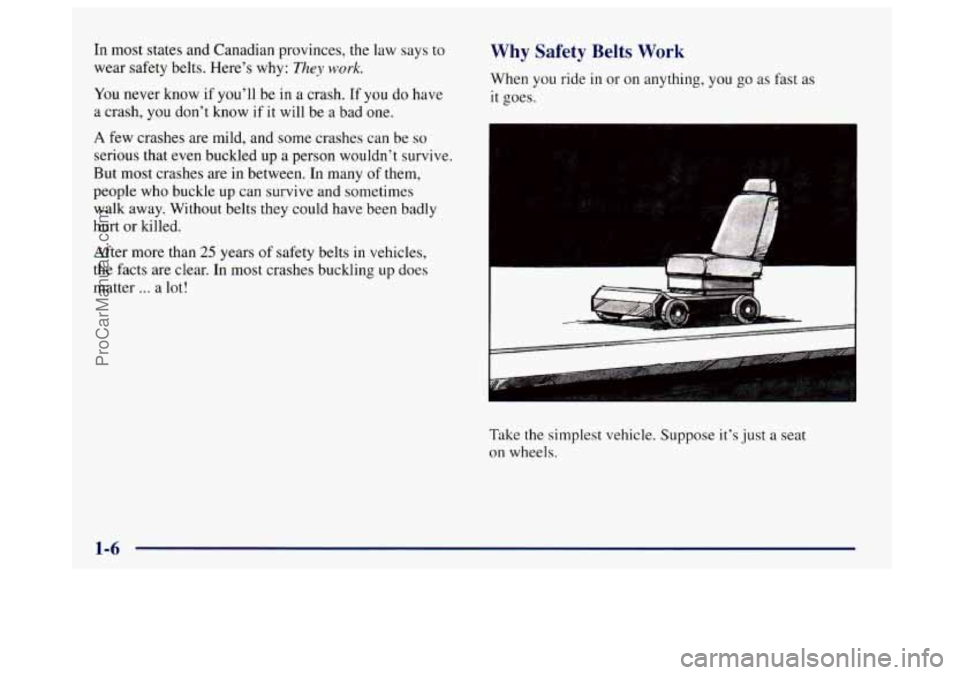
In most states and Canadian provinces, the law says to
wear safety belts. Here’s why:
They work.
You never know if you’ll be in a crash. If you do have
a crash, you don’t know if it will be a bad one.
A few crashes are mild, and some crashes can be so
serious that even buckled up a person wouldn’t survive.
But most crashes
are in between. In many of them,
people who buckle up can survive and sometimes
walk away. Without belts they could have been badly
hurt or killed.
After more than
25 years of safety belts in vehicles,
the facts are clear. In most crashes buckling
up does
matter
... a lot!
Why Safety Belts Work
When you ride in or on anything, you go as fast as
it goes.
.. ..
-- -7
Take the simplest vehicle. Suppose it’s just a seat
on wheels.
1-6
ProCarManuals.com